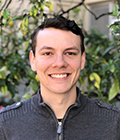
"Generation of Cranial Placode Progenitors through Directed Differentiation of Human Embryonic Stem Cells"
Host Mentors: Stefan Heller, Department of Otolaryngology, Kyle Loh, Insitute for Stem Cell Biology and Regenerative Medicine
Stanford University
Hearing loss and equilibrium disorders are the most frequent chronic detrimental conditions of the aging population, severely affecting their quality of life. Moreover, 1 in 500 teenagers suffer from severe hearing loss that is either manifest at birth or progressive in nature. The inner ear, responsible for auditory and vestibular function, is an organ that arises from the otic placode, a transient cranial structure that develops from an ectodermally-derived pre-placodal region lateral to the developing neural crest. The goal of this work is to create an in vitro platform for generating pre-placodal progenitors, a multipotent lineage that gives rise to not only the inner ear, but to all the cranial placodes during embryonic development. Hearing, smell, vision, and hormone secretion are some of the products of cranial placodes, but otic placodal progenitors have been notoriously difficult to generate in vitro. Guiding stem cells toward a placodal fate will be achieved by directing differentiation through their sequential precursors: definitive ectoderm, non-neural ectoderm, and pre-placode. Using signaling modulators of key developmental pathways, we aim to promote differentiation to a desired fate while discouraging commitment to undesired fates. Known markers will be used to inform the systematic optimization of a stepwise fate guidance of human embryonic stem cells towards definitive ectoderm, non-neural ectoderm, and finally pre-placodal ectoderm. Single cell-RNA sequencing of cells from each individual state will be utilized to provide deeper insight into the lineage transitions, but will also allow us to potentially identify more specific human markers of these lineages than currently available. Having a reliable and efficient protocol to generate well-characterized placodal progenitors will enable new regenerative strategies for the inner ear such as progenitor transplantation and the study of inner ear cells derived from induced pluripotent stem cells of patients with mutations that cause hearing loss.